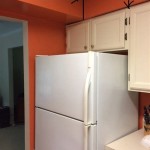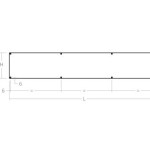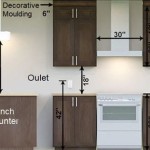How to Decorate Empty Space Above Kitchen Cabinets
The area above kitchen cabinets often represents a design challenge. Many kitchens, particularly those with standard-height cabinets, feature a significant gap between the cabinet tops and the ceiling. This space, if left unattended, can appear unfinished and become a magnet for dust. Effectively decorating this area can transform the overall aesthetic of the kitchen, adding visual interest, personality, and even perceived height to the room.
The approach to decorating above kitchen cabinets should be carefully considered, taking into account the kitchen's style, the homeowner's personal preferences, and the functionality desired. While some may opt for a minimalist approach, others might prefer bolder, more elaborate displays. Regardless of the chosen style, the ultimate goal is to create a cohesive and visually appealing space that complements the existing kitchen design.
Before beginning the decoration process, it is crucial to assess the amount of space available. Measure the height and depth of the area above the cabinets to determine the size and scale of the items that can be accommodated. Also, consider the accessibility of the space. Reaching high areas can be difficult, so selecting items that require minimal maintenance is advisable. Safety should also be a priority. Avoid placing heavy or unstable objects that could pose a falling hazard.
Key Point 1: Choosing a Style and Theme
The first step in decorating above kitchen cabinets is to determine a cohesive style and theme that complements the existing kitchen décor. This involves considering the color palette, architectural details, and overall ambiance of the kitchen. A consistent style will prevent the decorated space from appearing cluttered or disjointed.
For a modern kitchen, a minimalist approach may be most effective. This could involve displaying a few large, sculptural pieces in neutral colors, such as white ceramic vases or metal artwork. The emphasis should be on clean lines and simple forms. Alternatively, a more industrial aesthetic could be achieved by incorporating metal baskets, vintage signage, or reclaimed wood elements. The key is to maintain a sense of order and avoid overcrowding the space.
In a farmhouse or country-style kitchen, a more rustic and charming approach is often preferred. This could involve displaying vintage kitchenware, such as antique bowls, pitchers, or enamelware. Baskets filled with faux fruits or vegetables can also add a touch of warmth and texture. Consider incorporating natural elements, such as dried flowers, woven placemats, or wooden cutting boards. The goal is to create a cozy and inviting atmosphere that reflects the rustic character of the kitchen.
For a more traditional kitchen, consider arranging a collection of decorative plates or platters. These can be displayed on plate stands or hung on the wall using plate hangers. Family heirlooms or antique pieces can add a sense of history and character to the space. Alternatively, consider displaying a collection of cookbooks or vintage cookbooks, arranged neatly in stacks or displayed on bookends. The overall effect should be elegant and refined, reflecting the classic style of the kitchen.
The chosen theme should also reflect the homeowner's personal interests and hobbies. For example, a person who enjoys gardening might display a collection of terracotta pots, watering cans, and gardening tools. A wine enthusiast could showcase a selection of wine bottles, wine racks, or decorative wine glasses. Incorporating personal touches will make the space feel more unique and inviting.
Key Point 2: Selecting the Right Decorative Items
Once a style and theme have been established, the next step is to select the appropriate decorative items. The items chosen should be proportionate to the size of the space and complement the overall design. Consider the color, texture, and shape of the items to ensure they work well together and create a visually appealing display.
Baskets are versatile and functional decorative items that can be used in a variety of kitchen styles. Woven baskets can add texture and warmth to a space, while wire baskets can provide a more modern or industrial look. Baskets can be used to store decorative items, such as faux plants, kitchen towels, or cookbooks. They can also be used as standalone decorative elements, arranged in varying sizes and shapes.
Greenery, whether real or artificial, can add life and freshness to the kitchen. Consider placing potted plants, trailing vines, or faux floral arrangements above the cabinets. Choose plants that are appropriate for the amount of light available in the kitchen. If natural light is limited, opt for low-maintenance plants or high-quality artificial plants that look realistic. Arrange the greenery in a visually appealing manner, mixing different sizes and textures.
Decorative objects, such as vases, sculptures, and artwork, can add personality and visual interest to the space. Choose objects that complement the overall style and theme of the kitchen. Large-scale objects can make a statement, while smaller objects can be grouped together to create a more dynamic display. Consider the color and texture of the objects to ensure they work well with the surrounding décor.
Lighting can also be used to enhance the decorative elements above the cabinets. Consider installing under-cabinet lighting or spotlights to highlight specific objects or create a more dramatic effect. String lights can also add a touch of whimsy and warmth to the space. Choose lighting fixtures that are appropriate for the style of the kitchen and that provide adequate illumination.
Mirrors can be strategically placed above kitchen cabinets to create the illusion of more space and light. A large mirror can reflect the surrounding kitchen, making the room feel larger and brighter. Smaller mirrors can be grouped together to create a decorative display. Consider the shape and size of the mirrors to ensure they complement the overall design of the kitchen.
Key Point 3: Arrangement and Presentation
The arrangement and presentation of the decorative items are crucial to creating a visually appealing and cohesive display. The items should be arranged in a balanced and harmonious manner, taking into account the size, shape, and color of each item. Consider using the principles of design, such as symmetry, asymmetry, and the rule of thirds, to create a visually dynamic arrangement.
Start by placing the largest items first, as these will serve as the anchor for the arrangement. Position these items in a prominent location, such as the center of the space or on either side of the cabinets. Then, fill in the gaps with smaller items, arranging them in a way that creates visual balance and interest. Avoid placing too many items in one area, as this can make the space feel cluttered and overwhelming.
Vary the height of the items to create visual interest and dimension. Place taller items in the back and shorter items in the front. This will create a layered effect that draws the eye upward. Consider using risers or platforms to elevate some of the items and add further dimension to the display.
Use the principle of repetition to create a sense of unity and cohesion. Repeat colors, textures, or shapes throughout the arrangement to tie the elements together. This can be achieved by using items from the same collection or by incorporating similar materials or patterns. However, avoid being too repetitive, as this can make the display feel monotonous.
Consider the visual weight of the items when arranging them. Visual weight refers to the perceived heaviness or lightness of an object. Darker colors and larger objects tend to have more visual weight than lighter colors and smaller objects. Arrange the items in a way that balances the visual weight, preventing the display from feeling lopsided or unbalanced.
The space should be regularly maintained to ensure it remains clean and appealing. Dust the items regularly and remove any cobwebs or debris. Rotate the items seasonally or as desired to keep the display fresh and interesting. Consider adding new items or rearranging the existing items to create a new look. With careful planning and attention to detail, the space above kitchen cabinets can be transformed into a stylish and functional design element.

7 Trendy Ways To Decorate The Empty Space Above Kitchen Cabinets Neutrally Nicole

14 Ideas For Decorating Space Above Kitchen Cabinets How To Design Spot

14 Ideas For Decorating Space Above Kitchen Cabinets How To Design Spot

7 Trendy Ways To Decorate The Empty Space Above Kitchen Cabinets Neutrally Nicole

Decorate Above Kitchen Cabinets The Crazy Craft Lady

Closing The Space Above Kitchen Cabinets Remodelando La Casa

Filling In That Awkward Space Above The Cabinets Kitchen Progress Inspired Room

Pin On For The House

14 Ideas For Decorating Space Above Kitchen Cabinets How To Design Spot

21 Genius Ways To Use Space Above Your Kitchen Cabinets
Related Posts








